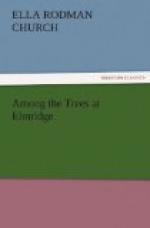“Perhaps not, after trying it and finding how much hard work there is in sugar-making,” replied his governess. “’The kettles must be carefully watched and plenty of wood brought to keep them boiling, and during the process the sap, or syrup, is strained; lime or salaeratus is added, to neutralize the free acid; and the white of egg, isinglass or milk, to cause foreign substances to rise in a scum to the surface. When it has been sufficiently boiled, the syrup is poured into moulds or casks to harden.’ The sugar with which the most pains have been taken is very light-colored, and I have seen it almost white.”
“Have you ever been to a sugar-camp, Miss Harson?” asked Clara, who was wishing, like Malcolm, that she could go to one herself.
“Yes,” said Miss Harson; “I did go once, in Vermont, when the family with whom I was staying took me to see the ‘sugaring off.’ This is putting it into the pans and buckets to harden after it has been sufficiently boiled and clarified; and we younger ones, by way of amusement, were allowed to make jack-wax.”
“Oh!” exclaimed three voices at once; “what is that? Is it good to eat?”
“I thought it particularly good,” was the reply, “and I am quite sure that you would agree with me. To make it, we poured a small quantity of hot syrup on the snow to cool; and when it was fit to eat, it was just like wax, instead of being hard like the cakes in moulds. It took only a few minutes, too, to make it, and it seemed a great deal nicer because we did it ourselves. I remember that it was the last of March and very cold, but there were big fires to get warmed at, and we had a delightful time.”
“Were there any Indians there, Miss Harson?” asked little Edith, after being quiet for some time. Vermont was such a long way off on the map, besides being up almost at the top, that Indians and bears and all sorts of wild things seemed to have a right to live there.
“No,” said her governess, smiling at the question; “I did not see one, even at the sugar-camp. Yet the Indians made maple-sugar long before we knew anything about it, and from them the white people learned how to do it.”
“Well, that’s the funniest thing!” exclaimed Malcolm. “I thought that Indians were always scalping people instead of making maple-sugar.”
“They did a great many other things, though, besides fighting, and their life was spent so much out of doors that they studied the nature of every plant and living thing about them. The healing-properties of some of our most valuable herbs were first discovered by the Indians, and, as they never had any grocery-stores, the presence of trees that would supply them with sugar was a blessing not likely to be neglected. The devoted missionary John Brainerd first heard of this tree-sugar from them, and it is said that he used to preach to them when they were thus peacefully employed, and obtained a better hearing than at other times.”




